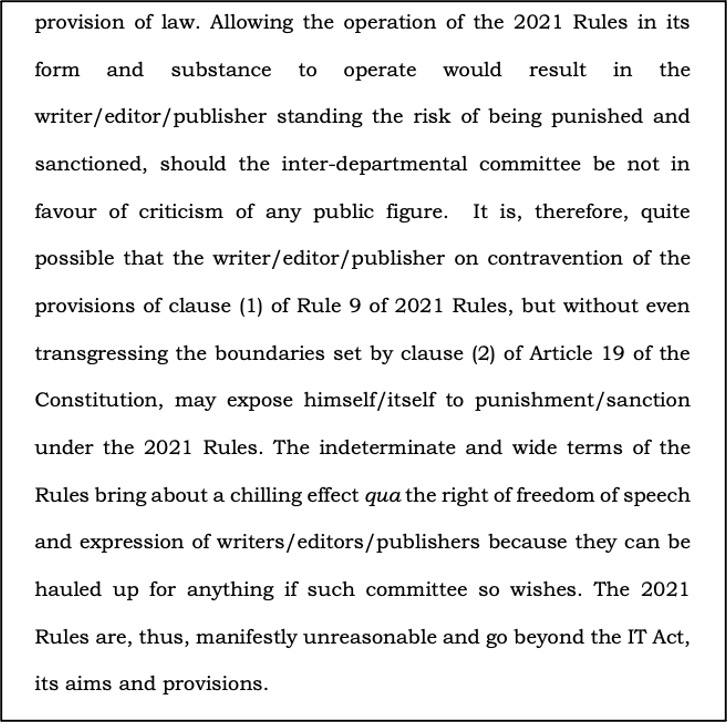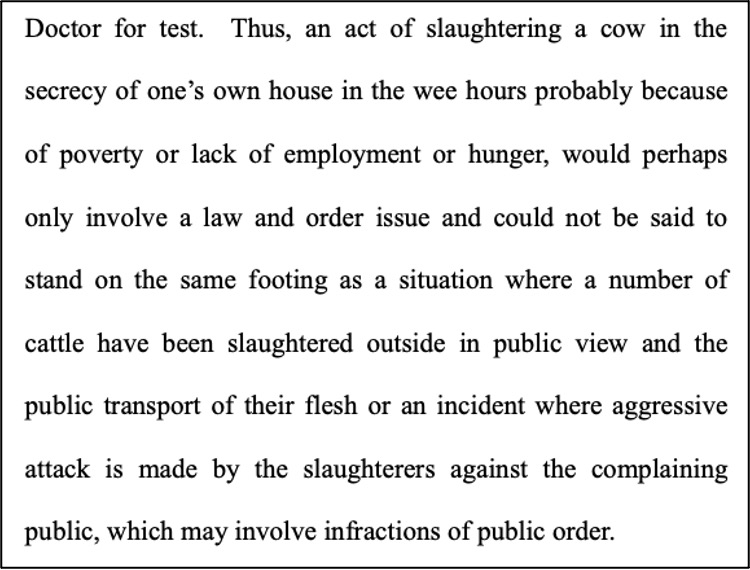In this roundup of court judgements, we look at Constitutional Courts’ remarks & directions on the effect of new IT rules on freedom of speech, implications of public order vis-à-vis the U.P. Prevention of Cow Slaughter Act, 1955, safety of women in public transport, and vacancies in consumer disputes redressal commissions.
Bombay HC: IT Rules 2021 manifestly unreasonable; bring chilling effect on free speech
In the case Agij Promotion of Nineteenonea Media Pvt. Ltd. Vs. Union of India, and Nikhil Mangesh Wagle Vs. Union of India, the Bombay high court stayed Rules 9(1) and 9(3) of the Information Technology (Guidelines For Intermediaries And Digital Media Ethics Code) Rules, 2021 which mandate that digital news media and online publishers should adhere to the “Code of Ethics” prescribed by the Rules.
The supreme court is hearing two petitions challenging the Information Technology (Guidelines for Intermediaries and Digital Media Ethics Code) Rules, 2021, which was announced to regulate the social media intermediaries, OTT platforms, and online news and current affairs websites. The Rules prescribing a Code of Ethics and a three-tier content regulation mechanism have been framed under the Information Technology Act, 2000. The Code of Ethics applies to publishers of online curated content and intermediaries. It stipulates that an applicable entity shall exercise due caution and shall take into consideration the following factors when deciding to feature any content on its platform:
- Content that affects the sovereignty and integrity of India
- Content that threatens endangers, or jeopardizes the security of the State
- Content that is detrimental to India’s friendly relations with foreign countries
- India’s multi-racial and multi-religious context
- Activities, beliefs, practices, or views of any racial or religious group in India
The high court opined that dissent is vital for the functioning of any healthy democracy but with the Rules operating in their present form, a journalist or news organisation exposes themselves to punishment even without transgressing the boundaries of reasonable restriction under Article 19(2) of Indian Constitution.
The Court made a prima facie observation that the Rules relating to digital media are beyond the substantive powers of delegated legislation given to the Union Government by the Information Technology Act.
The judgement explains that Rule 9 also prima facie appears to be infringing the constitutional guarantee of Freedom of Speech and Expression as conferred by Article 19(1)(a) in subjecting the publishers of news/current affairs content and publishers of online curated content subject to action under the statutory regime of the Press Council Act and the Cable TV Network (Regulation) Act, which provides for an independent mechanism for any violation of the provisions of such legislation.

Under the recently notified IT Rules, adherence to moral standards in the code has been exalted to the status of mandatory compliance. This would mean that violation of the guidelines would expose a person to more rigorous action than what was envisaged under the Press Council Act.
Therefore, the high court observed that the new 2021 IT Rules can have a chilling effect on freedom of speech, with a journalist or news publisher having to think twice before criticizing the State administration.
The bench however refused to stay Rules 14 and 16 of the IT Rules 2021, which deal with the constitution of an inter-departmental committee as an oversight mechanism over digital media and the power of the Centre to block access to content.
Allahabad HC: Cutting beef due to poverty, unemployment, or hunger in secrecy is not ‘public order’ issue
In the case Parvez Vs. State of Uttar Pradesh and others, Allahabad high court quashed a detention order passed under the National Security Act, 1980 against 5 men who have been accused of cutting small pieces of beef for selling purposes in a house in secrecy.
The high court was hearing a case against the detention of the five people under Sections 3/5/8 of the U.P. Prevention of Cow Slaughter Act, 1955 and Section 7 of the Criminal Law Amendment Act, 2013. Further, in order to maintain public order and that there was a likelihood of the petitioners/detainees being released on bail, the detaining authority passed an order detaining the petitioners/detainees under Section 3(2) of the National Security Act, 1980.

The detention order was passed on the ground that because of the acts of the detainees and co-accused, the sentiments of the Hindu community were hurt, and Hindu-Muslim harmony was adversely affected. It was alleged by the State of UP that when the news spread in the area, villagers of the Hindu community gathered near the house of the petitioners/detainees and communal amity was disturbed. While the police succeeded in assuaging the general public and taking steps for restoring public order, there was an atmosphere of fear and public order was disturbed.
Taking these submissions into consideration, the high court noted that whether the case involves public order, or is only a matter affecting law and order, depends upon the quality and degree of the act. In order words, whether the act has been done in the public gaze and in an aggressive manner with scant regard to the sentiments of the other community or whether it has been done in a concealed manner.
The Court noted that the incident took place in the secrecy of the petitioners/detainees house at 5.30 in the morning and it was a solitary incident of cutting cow beef in pieces away from the public eye. It is not clear if it was due to poverty or lack of employment or hunger. Therefore, it would perhaps only involve a law-and-order issue and could not be said to stand on the same footing as an act affecting public order.

In conclusion, the high court held that the detention order against them was passed without the presence of any material to indicate that the petitioners/detainees had any criminal history. Therefore, the high court directed the detention order and consequential orders to be quashed.
Calcutta HC: Display women helpline number in public transport
In the case Renu Pradhan Vs. The State of West Bengal and Ors., the Calcutta high court issued a host of directions to ensure the safety and security of women and transgender persons travelling in public transport buses.
The high court was hearing a plea by Ankani Biswas regarding the safety of women and transgender on public transport. The plea highlighted that women are frequently harassed and sometimes sexually assaulted while travelling in public buses.
A bench of Acting Chief Justice Rajesh Bindal and Justice Arijit Banerjee recommended the following:
- Display the women helpline number inside and outside the buses/ public transport vehicles and prominent places on different bus stands and bus stops.
- A separate helpline number be implemented for transgenders or a modification is done in the existing system that shall permit transgender persons to access the existing women helpline.
- Display the State Legal Services Authority helpline number in public transport buses to ensure that victims can take recourse to legal aid if required.
- Sensitisation programmes must be conducted in schools to prevent the occurrence of such crimes.
The court directed the State government as well as the Union to take note of the recommendations and accordingly ensure compliance, and other steps to ensure safety.
Supreme Court: Directs Centre, States to fill up vacancies In NCDRC & SCDRCs within 8 weeks
In a suo motu case taken to address the issue of unfilled vacancies in consumer disputes redressal commissions, the supreme court directed Union and State Governments to fill up the vacancies in the National and State Consumer Dispute Redressal Commissions (NCDRCs & SCDRCs) within 8 weeks.
Some states clarified that selection is held up as the number of posts has not been sanctioned in consultation with Central Government. The bench Justice Sanjay Kishan Kaul and Justice Hrishikesh Roy rejected this excuse given by the States by observing that as per the mandate of Section 42 of the Consumer Protection Act, the consultation with the Central Government is required only if the number of members is more than 4.
During the hearing, the bench considered whether the legislative impact study was undertaken before the new Consumer Protection Act of 2019 came into being. A legislative impact assessment is an informed law-making process under which social, economic, environmental and institutional impacts of legislative proposals are made.
The supreme court directed the Union Government to present the legislative impact study with respect to the Consumer Protection Act 2019 within 4 weeks.

The apex court also directed the Chief Secretaries of States & Centre (Secretary, Consumer) to be present in the virtual hearing on the next date in case of non-compliance with the directions regarding filling up of vacancies in Consumer Redressal Commissions.
Featured Image: IT Rules


